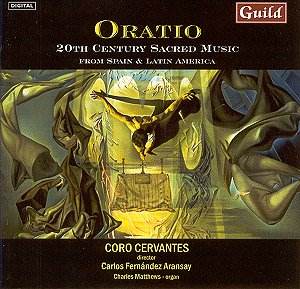The Coro Cervantes
is a London-based choir which specialises
in music from the Iberian peninsula.
This disc, their second on Guild, is
a survey of 20th century
Spanish (and South American) sacred
music. The music on the disc rather
divides into two categories: music by
composers that most people have never
heard of and music by composers that
people have heard of but did not realise
that they had written any liturgical
music. As such it sheds a wonderful
light on choral activity in Spain in
the 20th century. If a lot
of these pieces fall into the useful
and effective category, rather than
being inspired, this is probably because
a lot of it was written in response
to changes in need in the Spanish church.
There were three congresses on religious
music in 1907, 1912 and 1928 followed
by the civil war which changed the landscape
for ever. Then in 1962 the 2nd
Vatican council changed the church’s
attitude to religious music.
A Howells-like modality
combined with a hint of plainchant seems
to be the prevailing genre; pieces that
would work well in a liturgical context
but which do not always grab the attention
when played end to end on a CD. There
are some surprises. Ernesto Halffter’s
‘Oratio’ evinces no echoes of his great
teacher, de Falla, whereas his nephew
Cristobal Halffter’s ‘Panis Angelicus’
is a lovely setting for high voices,
with some austerely beautiful textures.
Frederic Mompou’s ‘Ave Maria’ lacks
the beautiful simplicity of his more
well known piano pieces. but Joaquín
Rodrigo’s ‘Ave Maria’ revels in its
rather interesting vocal textures. The
name Padre Donostia, a capuchin monk,
was new to me and he contributes a setting
of ‘O Jesu mi Dulcissime’ which manages
to avoid the obvious. Another surprisingly
successful work is Pau Casal’s sombre
setting of ‘O Vos Omnes’.
There are two organ
solos on the disc. The first, by Jesus
Guridi, has a vigorous opening which
sounds as if Guridi was listening to
too much Widor, but the piece succeeds
in being both tricky and effective if
not always very original. The second
solo, by Xavier Montsalvatge is the
first piece of real 20th
century modernism on the disc. This
fascinating work rather puts in the
shade the preceding, effective but derivative
works.
Abril’s two pieces,
which follow the Montsalvatge, go some
way to bridging the gap between the
generic modality of the earlier pieces
on the disc and the modernism of Montsalvatge.
The disc finishes with the work which
won the 1st prize in the
1997 ‘Juan Bautista Comes Choral Competition’.
This piece, ‘Speculum in aenigmatem’
by Cesar Cano is a fascinating and thought
provoking work and I would hope to hear
more of Cano’s work.
Possibly the strongest
piece on the disc is not even a liturgical
one. Alberto Ginastera’s ‘Hieremiae
prophetae lamentationes’, setting texts
he selected from the Lamentations of
Jeremiah, was written for concert use.
Written when the composer was in exile
in the USA in 1946, it opens the disc
with a howl. This is a tremendous piece
and it avoids being an obvious setting
of the familiar words. The music can
be rather tricky and there are just
hints of Ginastera’s flirtation with
serialism, but the choir sing the music
with a wonderful sense of line and achieve
a beautiful hushed tone in the middle
movement. There is a sense that the
piece stretches the choir to its limit
but this only adds to the sense of unease
and even discomfort that Ginastera manages
to generate.
The performances are
admirable for their clarity and accuracy;
the choir is spot on musically in all
this new music. If I have a criticism
it is the lack of Latin tone in the
pieces; instead we get a very English
sound: clear and accurate, perhaps a
little too cool. The Latin is not given
a Spanish pronunciation which seems
remiss.
The interesting disc
opens a window on an entirely different
musico-liturgical tradition. If not
all the pieces are entirely interesting,
they are welcome nonetheless for contributing
to a beautifully performed comprehensive
survey of Spanish 20th century
liturgical music.
Robert Hugill
see also review
by Hubert Culot

